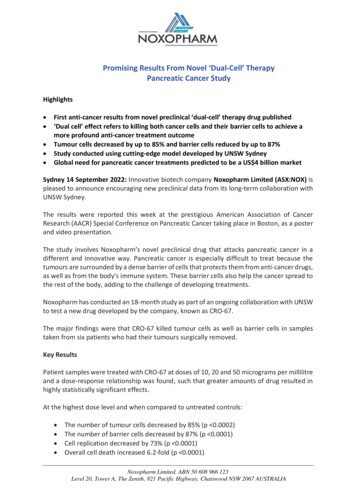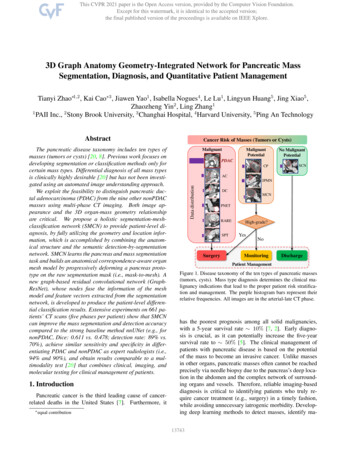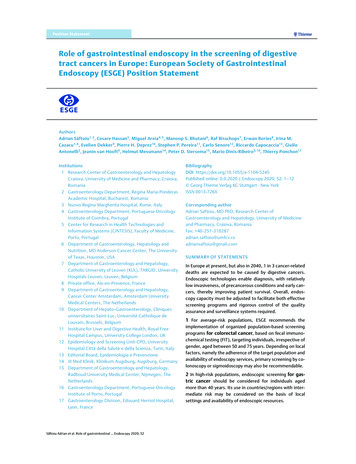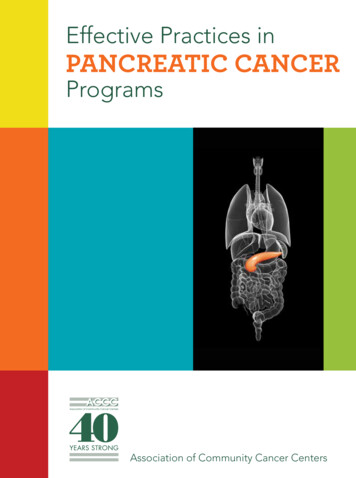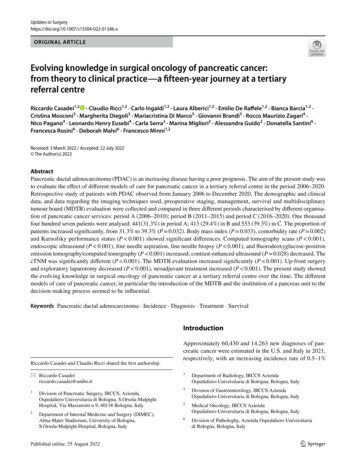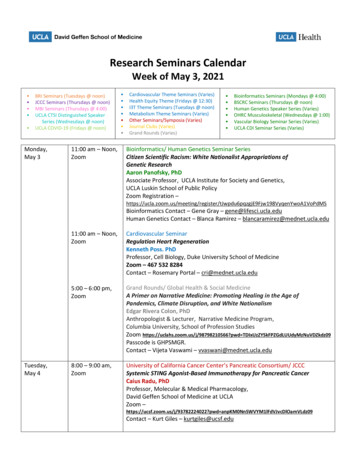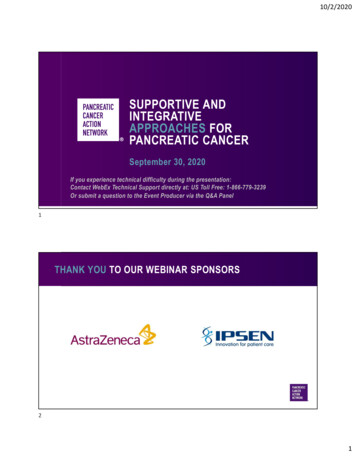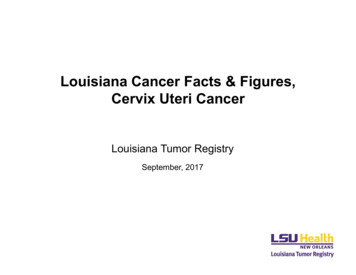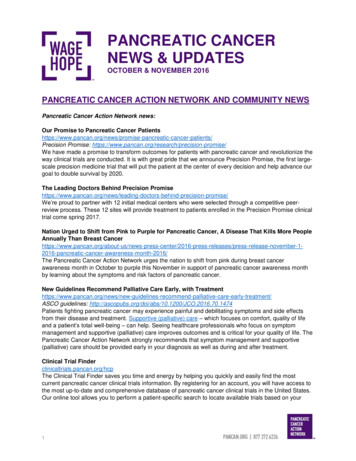
Transcription
PANCREATIC CANCERNEWS & UPDATESOCTOBER & NOVEMBER 2016PANCREATIC CANCER ACTION NETWORK AND COMMUNITY NEWSPancreatic Cancer Action Network news:Our Promise to Pancreatic Cancer atic-cancer-patients/Precision Promise: We have made a promise to transform outcomes for patients with pancreatic cancer and revolutionize theway clinical trials are conducted. It is with great pride that we announce Precision Promise, the first largescale precision medicine trial that will put the patient at the center of every decision and help advance ourgoal to double survival by 2020.The Leading Doctors Behind Precision -behind-precision-promise/We’re proud to partner with 12 initial medical centers who were selected through a competitive peerreview process. These 12 sites will provide treatment to patients enrolled in the Precision Promise clinicaltrial come spring 2017.Nation Urged to Shift from Pink to Purple for Pancreatic Cancer, A Disease That Kills More PeopleAnnually Than Breast 2016-pancreatic-cancer-awareness-month-2016/The Pancreatic Cancer Action Network urges the nation to shift from pink during breast cancerawareness month in October to purple this November in support of pancreatic cancer awareness monthby learning about the symptoms and risk factors of pancreatic cancer.New Guidelines Recommend Palliative Care Early, with s-recommend-palliative-care-early-treatment/ASCO guidelines: 74Patients fighting pancreatic cancer may experience painful and debilitating symptoms and side effectsfrom their disease and treatment. Supportive (palliative) care – which focuses on comfort, quality of lifeand a patient’s total well-being – can help. Seeing healthcare professionals who focus on symptommanagement and supportive (palliative) care improves outcomes and is critical for your quality of life. ThePancreatic Cancer Action Network strongly recommends that symptom management and supportive(palliative) care should be provided early in your diagnosis as well as during and after treatment.Clinical Trial Finderclinicaltrials.pancan.org/hcpThe Clinical Trial Finder saves you time and energy by helping you quickly and easily find the mostcurrent pancreatic cancer clinical trials information. By registering for an account, you will have access tothe most up-to-date and comprehensive database of pancreatic cancer clinical trials in the United States.Our online tool allows you to perform a patient-specific search to locate available trials based on your1
patients’ needs or a general search to understand the current clinical trials landscape to inform researchor trial design.Know Your TumorSM: Powerful Knowledge, Personal Treatmentpancan.org/knowyourtumor/hcpOur Know Your Tumor service is an IRB-approved protocol that provides you and your pancreatic cancerpatients with a molecular profiling report of their tumor, which includes personalized treatment options –including standard treatments, off-label treatments and available clinical trials. Treatment options aredetermined after findings of the molecular reports are interpreted by an expert panel, providing valuableinsight to support your treatment decisions.Patient Registrypancan.org/patientregistryThe Patient Registry is a global online database created to look for patterns in treatments, side effectmanagement and diagnostics that will lead to improved treatment options and outcomes for patients.Whether you have been diagnosed with pancreatic cancer or have provided care for someone withpancreatic cancer, your contributions are meaningful. By joining our quickly growing community andsharing your experiences, you’re giving researchers access to crucial data that will help makediscoveries. Together, we will move pancreatic cancer research forward.Funding opportunities:Apply now and coming soon! Pancreatic Cancer Action Network’s 2017 Research Grants pcoming deadlines:Precision Medicine Targeted Grant: Applications due February 15, 2017Early Detection Targeted Grants (will open Dec. 22): Applications due February 22, 2017KRAS Travel Scholarship applications accepted on a rolling basisWe are announcing two new funding opportunities – targeted grants in early detection and precisionmedicine – for up to 1 million each! Please apply today and spread the word! If you or your colleaguesdo not already receive funding alerts and updates directly from our organization, please emailresearch@pancan.org to be added to our mailing list.New! Consortium for Pancreatic Ductal Adenocarcinoma (PDAC) Translational Studies on theTumor Microenvironment /RFA-CA-17-015.htmlOpen date (earliest submission date): February 7, 2017Letter of Intent due date(s): February 7, 2016Application due date(s): March 7, 2017The purpose of this funding opportunity announcement (FOA) is to stimulate research in the area ofPDAC microenvironment with the ultimate goal of understanding the interaction between tumors and themicroenvironment. Studying tumor-microenvironment interactions in PDAC should lead to the discoveriesof vulnerabilities that could be exploited in the design of immunotherapies such as cancer vaccines,checkpoint inhibition, cellular therapies and their combination with other precision medicine interventionsand radiation therapy.New! Resource Center for the Consortium for Pancreatic Ductal Adenocarcinoma (PDAC)Translational Studies /RFA-CA-17-016.htmlOpen date (earliest submission date): February 7, 20172
Letter of Intent due date(s): February 7, 2016Application due date(s): March 7, 2017This funding opportunity announcement (FOA) invites applications to establish a Resource Center (RC)for the Consortium for Pancreatic Ductal Adenocarcinoma (PDAC) Translational Studies on the TumorMicroenvironment (Consortium) that has the ultimate goal to design new immunotherapy and combinationinterventions in PDAC.New! PDX Data Commons and Coordinating Center (PDCCC) for the PDX Development and TrialCenters Research Network (PDXNet) RFA-CA-17-004.htmlOpen date (earliest submission date): February 3, 2017Letter of Intent due date(s): 30 days prior to the application due dateApplication due date(s): March 3, 2017The purpose of this funding opportunity announcement (FOA) is to establish a PDXNet Data Commonsand Coordinating Center (PDCCC). PDCCC will interact with and coordinate with the PDX (PatientDerived Xenograft) Development and Trial Centers Research Network (PDXNet) comprised of four PDXDevelopment and Trial Centers (PDTCs, to be supported by companion FOA, RFA-CA-17-003) in acollaborative network.New! PDX Development and Trial Centers (PDTCs) RFA-CA-17-003.htmlOpen date (earliest submission date): February 3, 2017Letter of Intent due date(s): 30 days prior to the application due dateApplication due date(s): March 3, 2017This funding opportunity announcement (FOA) solicits applications for PDX (patient-derived xenografts)Development and Trial Centers (PDTCs) to serve as the laboratory research units of the PDXDevelopment and Trial Centers Research Network (PDXNet).The Pancreatic Cancer Detection Consortium AR-15-289.htmlDeadlines: May 26, 2017; September 21, 2017; April 6, 2018This Funding Opportunity Announcement (FOA) invites applications from multi-disciplinary teams ofresearchers and clinicians to establish the Pancreatic Cancer Detection Consortium (PCDC) to conductresearch to improve the detection of early stage pancreatic ductal adenocarcinoma (PDAC) andcharacterization of its precursor lesions.Job opportunities:Faculty Position: Assistant Professor of Cancer Cell Biologyhttps://www.ndsu.edu/biology/job openings/North Dakota State University is looking to hire an Assistant Professor of Cancer Cell Biology whoconducts pancreatic cancer research.Meetings:2017 Gastrointestinal Cancers Symposiumhttp://gicasym.org/Meeting: January 19 – 21, 2017, Moscone West Building, San Francisco, CAThe Gastrointestinal (GI) Cancers Symposium is a specialized oncology event designed to providescientific and educational content for members of the GI cancer care and research community. This three-3
day meeting encompasses the latest science in cancers of the esophagus and stomach; the pancreas,small bowel, and hepatobiliary tract; and the colon, rectum, and anus. This year’s Symposium offersbreakout sessions covering cutting-edge and controversial topics, a trainee and early-career networkingluncheon with noted faculty members, and the opportunity to view and discuss selected posters withrespected faculty members during poster walks.AACR Annual Meeting il.aspx?EventItemID 105#.WAFbpvkrLIUMeeting: April 1 – 5, 2017, Walter E. Washington Convention Center, Washington, D.C., USAThe AACR Annual Meeting highlights the best cancer science and medicine from institutions all over theworld. Attendees are invited to stretch their boundaries, form collaborations, attend sessions outside theirown areas of expertise, and learn how to apply exciting new concepts, tools, and techniques to their ownresearch.Pancreas Club Annual ng: May 5 – 6, 2017, Drake Hotel, Chicago, ILMark your calendars!Aspen Cancer ting: July 15 – July 18, 2017, the Gant Conference Center and Resort, Aspen, COThe Aspen Cancer Conference, a series of yearly meetings conceived by Drs. Benjamin F. Trump andCurtis C. Harris, was begun in 1985. The Conference has continued to emphasize the relationshipsbetween toxicity and carcinogenesis and the identification of novel strategies in cancer prevention,diagnosis, and therapy. It is evident that new paradigms are needed to explain that an increasing numberof mutagenic and non-mutagenic agents result in carcinogenesis, that cell injury and death, repair, andinflammation are constant companions of cancer.Other community news:Seven UCSF Scientists Receive NIH ‘Blue-Sky’ Research wards2016 New NIH Innovator Award Recipients: 16Rushika Perera, PhD, recipient of the 2016 Skip Viragh – Career Development Award, received a highlyprestigious New Innovator Award from the National Institutes of Health.NYU Langone’s Research Leader Receives Prestigious Award from the National Cancer d-from-thenational-cancer-instituteDafna Bar-Sagi, PhD, has been named a recipient of the Outstanding Investigator Award, a highlyprestigious honor presented by the National Cancer Institute (NCI). Dr. Bar-Sagi has received multipleresearch grants from the Pancreatic Cancer Action Network and is a member of the Scientific andMedical Advisory Board.Hirshberg Foundation Seed Grant t-program/seed-grant-recipients/The 2016-2017 Hirshberg Foundation for Pancreatic Cancer Research Seed Grant Award recipients havebeen announced. Among the recipients is Nada Kalaany, PhD, recipient of a 2015 Career DevelopmentAward.4
Dr. David Tuveson Named Director, NCI-Designated Cancer Center at Cold Spring lDavid Tuveson, MD, PhD, will succeed Dr. Bruce Stillman as Director of the Cold Spring HarborLaboratory (CSHL) Cancer Center. Dr. Tuveson’s research and clinical focus is pancreatic cancer, alethal malignancy that continues to lack effective clinical solutions. His research at CSHL is makingprogress toward finding a cure by detecting the disease earlier and designing novel therapeuticapproaches, based in part on pancreatic organoid technology that he has pioneered.Some Websites May Not Be Effective in Helping Pancreatic Cancer Patients Make OptimalTreatment /2016/storino-101816Cancer patients often turn to the Internet to find information about treatment options, but not all websitesare created equal. Websites featuring pancreatic treatment modalities differ significantly in the way theypresent information based on therapy type, according to new findings presented at the 2016 AnnualClinical Congress of the American College of Surgeons.Call for Papers: Case Reports in Pancreatic 0.1089/crpc.2015.29008.cfpCase Reports in Pancreatic Cancer is an open access journal publishing authoritative case reports on allaspects of pancreatic cancer diagnosis, management, treatment, and outcomes. The Journal enablesphysicians, surgeons, oncologists, and the team of professionals that determine and administer care toshare their experiences and foster communication and collaboration to optimize patient care. The Journalis currently seeking high quality case reports on pancreatic cancer to be published in future issues.BIOLOGY OF CANCERA Renewed Model of Pancreatic Cancer Evolution Based on Genomic Rearrangement 78 Journal: Nature Institution(s): Wellcome Trust Sanger Institute, Hinxton, UK, and others Corresponding author(s): Faiyaz Notta or Thomas Hudson Pancreatic Cancer Action Network-affiliated authors:o Michael Hollingsworth, PhD: member, Scientific and Medical Advisory Boardo Gloria Petersen, PhD: member, Scientific and Medical Advisory Board Major finding: The authors employed a genetic approach to delete the obligate mTORC2subunit Rictor and identified the critical times during which tumorigenesis requires mTORC2signaling. Targeting mTOR may be a potential therapeutic strategy in pancreatic cancer.LKB1 Loss Links Serine Metabolism to DNA Methylation and 7799657 Journal: Nature Institution(s): Massachusetts General Hospital, Boston, MA, and others Corresponding author(s): Nabeel Bardeesy Pancreatic Cancer Action Network-affiliated author: Nabeel Bardeesy, PhD: recipient, 2008Randy Pausch, PhD – Pilot Grant5
Major finding: The authors identify a network linking metabolic and epigenetic alterations that iscentral to oncogenic transformation downstream of the liver kinase B1 (LKB1, also known asSTK11) tumor suppressor, an integrator of nutrient availability, metabolism and growth.Leveraging Mechanisms Governing Pancreatic Tumorigenesis to Reduce Pancreatic /27461042 Journal: Trends in Endocrinology & Metabolism Institution(s): University of California Los Angeles, Los Angeles, CA Corresponding author(s): David Dawson Pancreatic Cancer Action Network-affiliated author: David Dawson, MD, PhD: recipient, 2008Seena Magowitz – Career Development Award Major finding: Central among these molecular signaling pathways that drive pancreatic ductaladenocarcinoma (PDA) is oncogenic KRAS, a mediator of cellular plasticity, metabolicreprogramming, and inflammatory and paracrine signaling required for tumor development andmaintenance. Biological aggressiveness is further conferred by a highly fibrotic andimmunosuppressive PDA microenvironment that also acts as a barrier to effective drug delivery.The regulation of these mechanisms and their implications for early cancer detection,chemoprevention and therapy are discussed.mTORC2 Signaling Drives the Development and Progression of Pancreatic Cancerhttps://www.ncbi.nlm.nih.gov/pubmed/27758884 Journal: Cancer Research Institution(s): University of Massachusetts Medical School, Worcester, MA, and others Corresponding author(s): Owen Sansom or Brian Lewis Pancreatic Cancer Action Network-affiliated authors:o Nabeel Bardeesy, PhD: recipient, 2008 Randy Pausch, PhD – Pilot Granto Brian Lewis, PhD: recipient, 2009 Constance Williams – Pilot Grant and 2006 MichaelLandon – Career Development Award Major finding: The authors employed a genetic approach to delete the obligate mTORC2subunit Rictor and identified the critical times during which tumorigenesis requires mTORC2signaling. Targeting mTOR may be a potential therapeutic strategy in pancreatic cancer.Heterogeneous Stromal Signaling within the Tumor Microenvironment Controls the Metastasis ofPancreatic Cancerhttps://www.ncbi.nlm.nih.gov/pubmed/27821486 Journal: Cancer Research Institution(s): Johns Hopkins University School of Medicine, Baltimore, MD, and others Corresponding author(s): Lei Zheng Pancreatic Cancer Action Network-affiliated author: Elizabeth Jaffee, MD: member, EmeritusScientific and Medical Advisory Board Major finding: The authors’ results illuminate tumor-stromal interactions which drive metastasis,and provide a mechanism-based rationale for a stroma-directed therapy for pancreatic ductaladenocarcinoma.Glycoproteins and Glycoproteomics in Pancreatic Cancerhttps://www.ncbi.nlm.nih.gov/pubmed/27895417 Journal: World Journal of Gastroenterology Institution(s): University of Washington, Seattle, WA Corresponding author(s): Sheng Pan6
Pancreatic Cancer Action Network-affiliated authors:o Teresa Brentnall, MD: member, Emeritus Scientific and Medical Advisory Boardo Ru Chen, PhD: recipient, 2006 Career Development AwardMajor finding: Recent advance in glycoproteomics, glycomics and other chemical biologytechniques have been employed to better understand the complex mechanism of glycosylationevents and how they orchestrate molecular activities in genomics, proteomics and metabolomicsimplicated in pancreatic adenocarcinoma. A variety of strategies have been demonstratedtargeting protein glycosylation and polysaccharides for diagnostic and therapeutic development.TIMPing Fate: Why Pancreatic Cancer Cells Sojourn in the eview of: https://www.ncbi.nlm.nih.gov/pubmed/27506299 Journal: Gastroenterology Institution(s): New York University School of Medicine, New York, NY Corresponding author(s): Alejandro Torres-Hernandez Pancreatic Cancer Action Network-affiliated author: George Miller, MD: recipient, 2014 CelgeneCorporation – Innovative Grant Major finding: In this issue of Gastroenterology, Grünwald et al investigate the biologicunderpinnings of pancreatic cancer liver metastases. The paper adds to the growing body ofliterature that demonstrates that the liver-specific metastatic niche develops early during theprogression of pancreas cancer. Measuring tissue inhibitor of metalloproteinases-1 (TIMP-1) mayrepresent a viable potential screening modality, and warrants further attention.Cancer-associated Fibroblast-derived Annexin A6 Extracellular Vesicles Support PancreaticCancer 27701147 Journal: Journal of Clinical Investigation Institution(s): INSERM, Marseilles, France, and others Corresponding author(s): Richard Tomasini Major finding: The authors’ findings suggest that cancer-associated fibroblast (CAF)-tumor cellcrosstalk supported by annexin A6 extracellular vesicles is predictive of pancreatic ductaladenocarcinoma (PDA) aggressiveness, highlighting a therapeutic target and potential biomarker forPDA.Pancreatic Cancer: Fast or l/nrc.2016.128.htmlReview of: https://www.ncbi.nlm.nih.gov/pubmed/27732578 Journal: Nature Reviews Cancer Institution(s): Nature editorial offices, London, UK Corresponding author(s): Sarah Seton-Rogers Major finding: Despite extensive research into pancreatic ductal adenocarcinoma (PDAC), thedisease continues to have high mortality rates. The most widely accepted model of PDACdevelopment is stepwise, involving sequential acquisition of independent mutations in several keyoncogenes and tumor suppressors.Pancreatic Cancer: Mapping Malignant Tissue 27Review of: https://www.ncbi.nlm.nih.gov/pubmed/27646934 Journal: Nature Reviews Gastroenterology & Hepatology Institution(s): Nature editorial offices, London, UK7
Corresponding author(s): Iain DicksonMajor finding: New research has identified the molecular networks underlying pancreatic regenerationand early carcinogenesis, revealing distinct dynamic patterns of proliferation between differentpancreatic cell types.Abstracts of Papers Submitted to the 47th Meeting of the American Pancreatic Association,October 26–29, 2016, Boston, al/Fulltext/2016/11000/Abstracts of Papers Submitted to the 47th Meeting.21.aspxAbstracts of papers submitted to the 47th Meeting of the American Pancreatic Association, October 26–29, 2016, Boston, MassachusettsETIOLOGYHuman oral microbiome and prospective risk for pancreatic cancer: a population-based nestedcase-control ancreatic Cancer Action Network Latest News blog post: ncreatic-cancer-risk-grantee-study/ Journal: Gut Institution(s): New York University School of Medicine, New York, NY, and others Corresponding author(s): Jiyoung Ahn Pancreatic Cancer Action Network-affiliated authors:o George Miller, MD: recipient, 2014 Celgene Corporation – Innovative Granto Jiyoung Ahn, PhD: recipient, 2012 The Daniel and Janet Mordecai Foundation – CareerDevelopment Award Major finding: Carriage of oral pathogens, Porphyromonas gingivalis and Aggregatibacteractinomycetemcomitans, were associated with higher risk of pancreatic cancer.Phylum Fusobacteria and its genus Leptotrichia were associated with decreased pancreaticcancer risk. This study provides supportive evidence that oral microbiota may play a role in theetiology of pancreatic cancer.Leucocyte Telomere Length, Genetic Variants at the TERT Gene Region and Risk of Pancreatic Cancerhttps://www.ncbi.nlm.nih.gov/pubmed/27797938 Journal: Gut Institution(s): Brigham and Women's Hospital, and Harvard Medical School, Boston, MA, andothers Corresponding author(s): Ying Bao Pancreatic Cancer Action Network-affiliated author: Brian Wolpin, MD, MPH: co-PI, 2016 TheShirley Sadoff – Research Acceleration Network-2 Grant Major finding: Telomere shortening occurs as an early event in pancreatic tumorigenesis, andgenetic variants at the telomerase reverse transcriptase (TERT) gene region have beenassociated with pancreatic cancer risk. Prediagnostic leucocyte telomere length and geneticvariants at the TERT gene region were associated with risk of pancreatic cancer.Pancreatic Cancer Risks Associated with Prediagnostic Plasma Levels of Leptin and LeptinReceptor Genetic 7780823 Journal: Cancer Research8
Institution(s): Dana-Farber Cancer Institute, Boston, MA, and othersCorresponding author(s): Brian WolpinPancreatic Cancer Action Network-affiliated author: Brian Wolpin, MD, MPH: co-PI, 2016 TheShirley Sadoff – Research Acceleration Network-2 GrantMajor finding: Leptin is an adipokine involved in regulating energy balance which has beenidentified as a potential biological link in development of obesity-associated cancers such aspancreatic cancer. Higher prediagnostic levels of plasma leptin were associated with an elevatedrisk of pancreatic cancer among men, but not among women.Obstructive Sleep Apnea and Pathological Characteristics of Resected Pancreatic ubmed/27732623 Journal: PLoS One Institution(s): The Johns Hopkins University School of Medicine, Baltimore, MD Corresponding author(s): Michael Goggins Pancreatic Cancer Action Network-affiliated authors:o Ralph Hruban, MD: member, Emeritus Scientific and Medical Advisory Boardo Michael Goggins, MD: PI, 2013 Skip Viragh – Inaugural Research Acceleration NetworkGrant Major finding: The observed pathological differences between obstructive sleep apnea (OSA)associated and non-OSA-associated pancreatic cancers supports the hypothesis that OSA caninfluence the pathologic features of pancreatic ductal adenocarcinoma.Dietary Acrylamide and the Risk of Pancreatic Cancer in the International Pancreatic Cancer CaseControl Consortium 6 Journal: Annals of Oncology Institution(s): University of Milan, Milan, Italy, and others Corresponding author(s): Claudio Pelucchi Major finding: This Pancreatic Cancer Case-Control Consortium (PanC4)-pooled-analysis foundno association between dietary acrylamide and pancreatic cancer.Testicular Cancer: Radiotherapy Increases Pancreatic Cancer view of: https://www.ncbi.nlm.nih.gov/pubmed/27599043 Journal: Nature Reviews Urology Institution(s): Nature editorial office, London, UK Corresponding author(s): Peter Sidaway Major finding: Data from a retrospective study indicate that survivors of testicular cancer whosetreatment included abdominal radiotherapy have an increased risk of secondary pancreaticcancer that persists for decades after their original diagnosis.EARLY DETECTION, DIAGNOSIS, AND PROGNOSISAssessment of a Revised Management Strategy for Patients with Intraductal Papillary MucinousNeoplasms Involving the Main Pancreatic Ducthttps://www.ncbi.nlm.nih.gov/pubmed/27829085 Journal: JAMA Surgery9
Institution(s): David Geffen School of Medicine at University of California, Los Angeles (UCLA),Los Angeles, CACorresponding author(s): Yves Boucher or Alexander GuimaraesPancreatic Cancer Action Network-affiliated author: Yves Boucher, PhD: recipient, 2013 AbbySobrato – Innovative GrantMajor finding: Magnetic resonance imaging (MRI) using FDA-approved magnetic iron oxidenanoparticles (MNPs) provides a noninvasive, translatable means of assaying microvascularparameters induced by losartan in pancreatic cancer. Positron emission tomography(PET) measurements demonstrated that losartan, an angiotensin II receptor blocker, significantlyincreased the uptake of 18F-5FU.Noninvasive Assessment of Losartan-Induced Increase in Functional Microvasculature and DrugDelivery in Pancreatic Ductal 27751347 Journal: Translational Oncology Institution(s): Massachusetts General Hospital, Charlestown, MA, and others Corresponding author(s): Timothy Donahue Pancreatic Cancer Action Network-affiliated author: David Dawson, MD, PhD: recipient, 2008Seena Magowitz – Career Development Award Major finding: In this single-center, retrospective analysis, a main pancreatic duct (MPD) diameterof 7.2 mm was identified as an optimal cutoff for a prognostic factor for malignant disease in mainduct or mixed intraductal papillary mucinous neoplasm (IPMN). These data support lowering theaccepted criteria for MPD diameter when selecting patients for resection vs surveillance so as notto overlook cancer in IPMN.Circulating Tumor Cells Expressing Markers of Tumor Initiating Cells Predict Poor Survivaland Cancer Recurrence in Patients with Pancreatic Ductal 27789528 Journal: Clinical Cancer Research Institution(s): Johns Hopkins Medical Institutions, Baltimore, MD Corresponding author(s): Katherine Poruk Pancreatic Cancer Action Network-affiliated authors:o Michael Goggins, MD: PI, 2013 Skip Viragh – Inaugural Research Acceleration NetworkGranto Zeshaan Rasheed, MD, PhD: recipient, 2010 Tempur-Pedic Retailers – Pathway toLeadership Grant Major finding: Circulating tumor cells labeling with one or more markers of tumor initiating cellsare found in a majority of pancreatic ductal adenocarcinoma patients and are independentlypredictive of decreased disease free and overall survival.Imaging in Pancreatic 7 Journal: Nature Reviews Gastroenterology & Hepatology Institution(s): University of Virginia, Charlottesville, VA, and others Corresponding author(s): Kimberly Kelly Pancreatic Cancer Action Network-affiliated authors:o Teresa Brentnall, MD: member, Emeritus Scientific and Medical Advisory Boardo Kimberly Kelly, PhD: recipient, 2007 Laurie and Paul MacCaskill – Career DevelopmentAward and member, Emeritus Scientific and Medical Advisory Board10
Major finding: In this Review, the authors discuss and identify gaps in the use of imagingtechniques for the early detection and appropriate treatment stratification of various pancreaticdiseases, including diabetes mellitus, acute and chronic pancreatitis and pancreatic cancer.Imaging techniques discussed are MRI, CT, PET and ultrasonography. Additionally, theidentification of new molecular targets for imaging and the development of contrast agents thatare able to give molecular information in noninvasive radionuclear imaging and ultrasonographyare emerging areas of innovation that could lead to increased diagnostic accuracy and improvedpatient outcomes.Type 3c (Pancreatogenic) Diabetes Mellitus Secondary to Chronic Pancreatitis and langas/article/PIIS2468-1253(16)30106-6/abstract Journal: The Lancet Gastroenterology & Hepatology Institution(s): The Ohio State University Wexner Medical Center, Columbus, OH, and others Corresponding author(s): Phil Hart Major finding: In this R
for the Consortium for Pancreatic Ductal Adenocarcinoma (PDAC) Translational Studies on the Tumor Microenvironment (Consortium) that has the ultimate goal to design new immunotherapy and combination interventions in PDAC. New! PDX Data Commons and Coordinating Center (PDCCC) for the PDX Development and Trial Centers Research Network (PDXNet) (U24)
